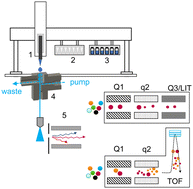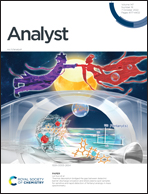Analysis of illicit pills and drugs of abuse in urine samples using a 3D-printed open port probe hyphenated with differential mobility spectrometry-mass spectrometry†
Abstract
The present work describes the application of an in-house developed 3D-printed open port probe (3DP-OPP) with differential ion mobility spectrometry (DMS) mass spectrometry. Targeted quantitative analysis in urine was performed with a triple quadrupole mass spectrometer in the selected reaction monitoring mode (OPP-DMS-SRM/MS) and illicit pill screening using data independent acquisition (OPP-DMS-SWATH/MS). The combination of compensation voltage (CoV) scanning in DMS using modifiers with SWATH/MS acquisition for MS/MS spectrum generation enabled the differentiation of isobaric signals with a large dynamic range and enhance the information contained in the screening of illicit ecstasy pills. As for any direct MS introduction technique where no chromatographic separation is applied DMS with acetonitrile as a modifier allows the separation of cocaine and tramadol, and their isomeric metabolites in urine samples. Quantitative application using OPP-DMS-SRM/MS is presented without the need for sample preparation with a lower limit of quantification at 10–25 ng mL−1 for the analytes and less than 40 seconds for sample to sample analysis.

- This article is part of the themed collection: 150th Anniversary Collection: Mass Spectrometry


 Please wait while we load your content...
Please wait while we load your content...